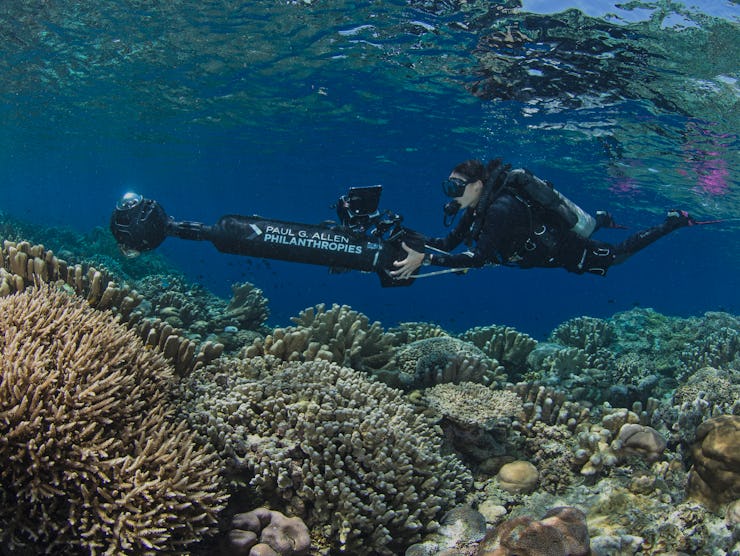A.I. Researchers Have an Ingenious New Plan to Save Coral Reefs
It also involves scuba diving with 360-degree cameras, which sounds fun.

Climate change has been bleaching coral reefs, decimating the local marine species that call them home, since at least the first major observations were recorded in the Caribbean in 1980. Thankfully, new A.I. cataloguing designed to identify the geographic regions where coral is still thriving hopes to reverse the trend, saving some of the world’s most dense and varied aquatic ecosystems from all-but-certain extinction.
There are numerous reasons why we need to care about saving coral reefs, from the ethical to the economic. In addition to housing about a quarter of marine species, these reefs provide $375 billion USD in revenue to the world economy, according to the Guardian, and food security to half a billion people. Without them, researchers say countless species and the entire ocean fishing industry that depends on them would simply evaporate.
The problem is that there’s only so much money and so much time to devote to mitigating the damage already in progress, while the 172 nations who ratified the United Nations Framework Convention on Climate Change “Paris Agreement” race to cut back on their carbon emissions. But an international consortium of researchers say they hope that artificial intelligence can fill in the gaps, and help the reefs get the attention and resources they need to survive.
Coral reefs provide a habitat for millions of species, and contribute billions to the global economy.
The solution involved a team of researchers deploying underwater scooters with 360-degree cameras photographing 1487 square miles of reef off the coast of Sulawesi Island in Indonesia. (Sulawesi, nestled in the middle of the Coral Triangle is surrounded by the highest concentration of marine biodiversity on the planet.)
Those images were then fed into a form of deep learning A.I. that had been taught over the course of 400 to 600 images to identify types of coral, and other reef invertebrates, to assess that region’s ecological health.
“The use of A.I. to rapidly analyze photographs of coral has vastly improved the efficiency of what we do,” Emma Kennedy, PhD., a benthic marine ecologist at the University of Queensland, said in a statement. “What would take a coral reef scientist 10 to 15 minutes now takes the machine a few seconds.”
“The machine learns in a similar way to a human brain, weighing up lots of minute decisions about what it’s looking at until it builds up a picture and is confident about making an identification.”
Kennedy and other researchers have also been using a custom, iterative clustering algorithm to identify coral reefs across the world that seem most likely to benefit from conservation resources. Their formula is based on 30 metrics known to impact coral reef ecology, broadly divided into categories like historical activity, thermal conditions, cyclone wave damage, and coral larvae behavior. A map of these prime sites for future coral conservation was published in Conservation Letters, a journal of the Society for Conservation Biology late this July.
Areas on the map labelled 'a' through 'e' represent coral reefs that are doing well and would benefit from conservation efforts while reefs 'f' through 'j' were determined to be too far gone. On the pie charts, each radial segment represents a single metric, and how that metric contributes to the current damage to the reef or the predicted damage in the future.
The research was made possible by generous donations from the Australian government, the Nature Conservancy, Bloomberg Philanthropies, the Tiffany & Co. Foundation, and the Paul G. Allen Family Foundation, whose namesake’s pleasure barge has a notable record in the field of coral reef depletion.
Kennedy and her team hope that these A.I. techniques will be further refined to help manage coral reefs on the more local level as well as several ecologically significant sites, including the Meso‐American Barrier Reef and the corals in Hawaii, both of which had to be excluded from their study.
Local versions of their global study, they believe, would benefit from data that is not uniformly available for reefs internationally: information about ocean chemistry, the ‘adaptive capacity’ of local reefs to withstand climate change or other stress on their systems, or the particulars of the local economic dependence on these coral reefs.